Introduction
Thai cuisine has captured the hearts and palates of food lovers around the world with its vibrant flavors, aromatic ingredients, and harmonious balance of sweet, sour, salty, and spicy elements. The popularity of Thai food can be attributed to its rich culinary history and the incorporation of fresh herbs and spices, which bring dishes to life in a way that few other cuisines can. Among the many delicious offerings that represent this culinary tradition, Panang curry stands out as a beloved dish known for its uniquely rich and creamy texture, paired with a bold flavor profile.
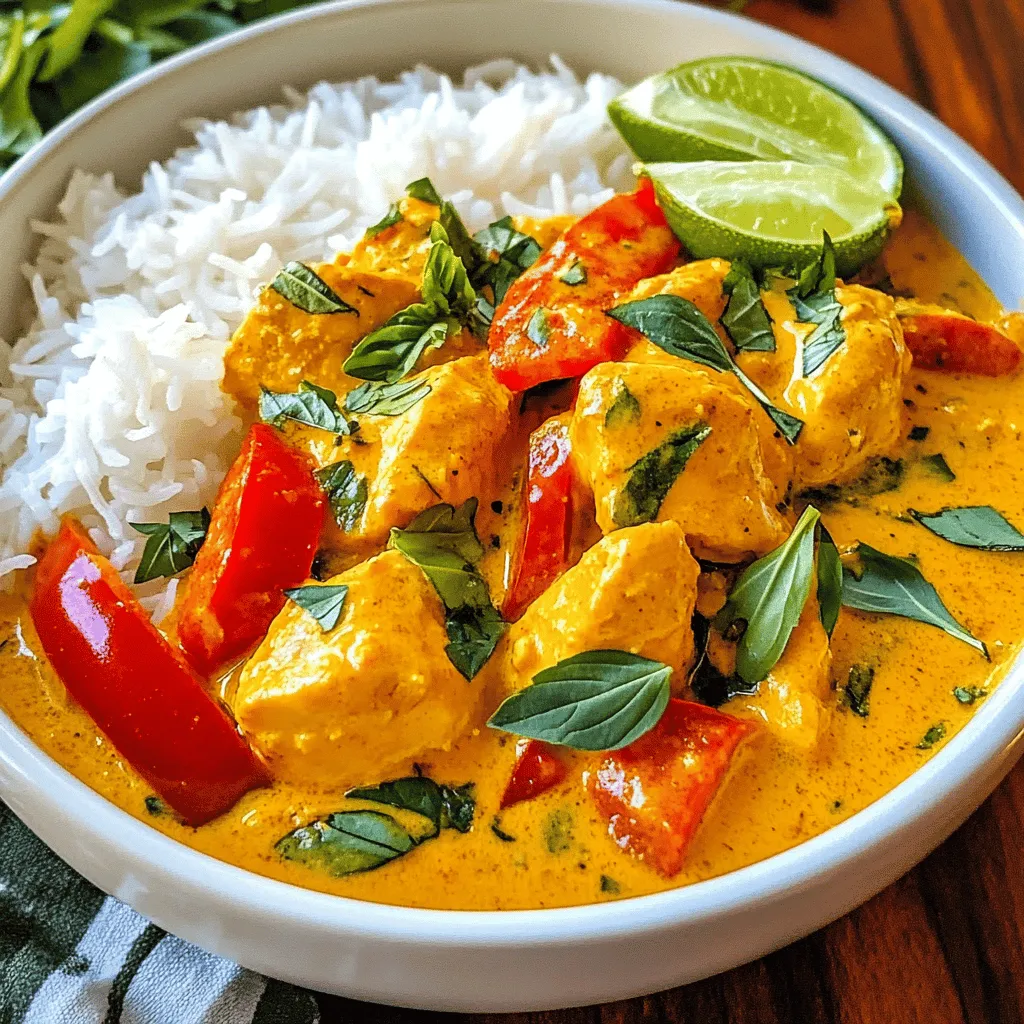
Panang curry is a type of Thai curry that is typically thicker and creamier than its counterparts, thanks to the generous use of coconut milk and a distinct curry paste. What makes Rich & Creamy Chicken Panang Curry particularly special is the combination of tender chicken thigh fillets simmered in a luxurious sauce, infused with aromatic herbs and spices, creating a dish that warms the soul. This article will provide a detailed recipe for making this exquisite dish, as well as explore the essential components that contribute to its irresistible taste and texture.
Understanding Panang Curry
Origins and History of Panang Curry in Thai Culture
The origins of Panang curry can be traced back to the central region of Thailand, where it has become an integral part of Thai cuisine. Named after the island of Penang in Malaysia, Panang curry is believed to have been influenced by the culinary practices of the Malay people. Over time, this dish has evolved and become a staple in Thai households and restaurants alike. Traditionally, Panang curry is made with beef, but chicken and other proteins have gained popularity due to their availability and flavor compatibility.
The preparation of Panang curry typically involves the use of homemade or store-bought curry paste, which is the heart of the dish. This paste is made from a blend of fresh herbs, spices, and other flavoring agents, giving the curry its characteristic depth and richness. The dish is often garnished with kaffir lime leaves and Thai basil, enhancing its aromatic appeal and adding a touch of authenticity to the final presentation.
Differences Between Panang Curry and Other Thai Curries
While Panang curry shares similarities with other Thai curries, such as red curry and green curry, there are distinct differences that set it apart. One of the most notable differences is the consistency and richness of the sauce. Panang curry is thicker and creamier, primarily due to the higher ratio of coconut milk and the use of less liquid compared to other curries. Additionally, the flavor profile of Panang curry is more pronouncedly sweet and savory, with a hint of nuttiness from the peanuts often included in the curry paste.
Another key differentiator is the type of herbs and spices used in the curry paste. Panang curry paste typically contains dried red chilies, galangal, lemongrass, shallots, garlic, and kaffir lime zest, among other ingredients. In contrast, green curry paste incorporates fresh green chilies, and red curry paste has a more straightforward blend of red chilies, making the flavors of each curry distinct.
Key Ingredients That Define the Flavor Profile of Panang Curry
The flavor of Rich & Creamy Chicken Panang Curry is built upon a foundation of carefully selected ingredients that work together to create a harmonious dish. At the heart of this curry is the Panang curry paste, which serves as the flavor powerhouse. The paste is often made from a combination of fresh and dried ingredients that lend depth and complexity to the dish.
Coconut milk is another crucial component, contributing not only to the creamy texture of the curry but also to the subtle sweetness that balances the heat of the spices. Fish sauce adds a layer of umami that enhances the overall flavor, while brown sugar provides a touch of sweetness to round out the dish. The aromatic notes of kaffir lime leaves and the crunch of red bell pepper bring freshness and brightness to the curry, making it a truly delightful culinary experience.
Ingredients Breakdown
To create the Rich & Creamy Chicken Panang Curry, it’s essential to gather the following ingredients, each playing a vital role in crafting the dish:
Chicken Thigh Fillets
Using chicken thigh fillets instead of chicken breasts is highly recommended for this recipe due to their higher fat content, which results in a juicier and more flavorful dish. Thighs are less prone to drying out during cooking, making them an ideal choice for a curry that simmers for a longer time. The tender texture of the chicken thighs absorbs the flavors of the curry beautifully, enhancing the overall taste.
Panang Curry Paste
The heart and soul of any Panang curry is the curry paste. This blend of ingredients typically includes dried red chilies, garlic, shallots, lemongrass, galangal, and kaffir lime zest, among others. The paste can often be found in Asian grocery stores or online, or you can make your own from scratch. Making your own allows you to control the level of spice and freshness, but store-bought versions are also a great convenience.
Coconut Milk
Coconut milk is what gives Panang curry its rich and creamy texture. It adds a subtle sweetness and a velvety mouthfeel that complements the spices perfectly. When selecting coconut milk, look for full-fat versions for the best results, as they provide the most creaminess and flavor. Light coconut milk can be used for a lower-calorie option, but the curry may lack some of its signature richness.
Fish Sauce
Fish sauce is a staple in Thai cooking, providing a necessary umami flavor that enhances the dish. It is made from fermented fish, typically anchovies, and offers a salty, savory depth to the curry. While it might seem intimidating to some, the flavor it imparts is integral to achieving an authentic taste. For those with dietary restrictions, soy sauce or tamari can be used as a substitute, though the flavor may differ slightly.
Brown Sugar
Incorporating brown sugar into the Panang curry helps to balance the flavors by adding a touch of sweetness. This sweetness counteracts the heat from the curry paste and the saltiness of the fish sauce, creating a well-rounded dish. If you prefer a healthier alternative, you can use coconut sugar or agave syrup.
Kaffir Lime Leaves
Kaffir lime leaves are a key ingredient in many Thai dishes, including Panang curry. Their unique aroma adds a refreshing citrus note that elevates the dish. When using kaffir lime leaves, simply tear them to release their oils before adding them to the curry. If you cannot find fresh leaves, dried leaves can be used as a substitute, although the flavor will be less intense.
Red Bell Pepper
Red bell pepper adds a splash of color and a sweet crunch to the curry. It complements the tender chicken and creamy sauce beautifully. You can also experiment with other vegetables, such as snap peas or carrots, depending on your preference.
Thai Basil
Thai basil is another essential herb that adds a distinct flavor and aroma to the dish. Its slightly spicy and sweet notes pair wonderfully with the richness of the curry. If you cannot find Thai basil, regular basil can be used in its place, though the flavor will differ.
Vegetable Oil
Vegetable oil is used as the cooking medium for sautéing the curry paste and chicken. While any neutral oil will work, options like coconut oil can enhance the dish’s flavor, contributing to its tropical essence.
Ingredient Substitutions for Dietary Preferences
This Rich & Creamy Chicken Panang Curry recipe can easily be adapted for different dietary preferences. For a vegetarian or vegan version, substitute the chicken with tofu or a medley of vegetables like eggplant, zucchini, and mushrooms. Use vegetable broth or coconut cream instead of chicken stock to maintain richness, and ensure that the curry paste is free from animal products. Additionally, you can replace fish sauce with soy sauce or a homemade vegan alternative.
Step-by-Step Cooking Instructions
Now that we have discussed the key ingredients and their roles in creating the perfect Rich & Creamy Chicken Panang Curry, let’s go through the step-by-step cooking instructions. Following these steps will help you achieve a dish that is not only flavorful but also visually appealing.
1. Prepare the Ingredients: Start by gathering and preparing all the ingredients. Cut the chicken thigh fillets into bite-sized pieces, deseed and slice the red bell pepper, and tear the kaffir lime leaves. If you are using fresh Thai basil, rinse and pat them dry.
2. Heat the Oil: In a large skillet or wok, heat about 2 tablespoons of vegetable oil over medium heat. Once the oil is hot, add the Panang curry paste. Sauté the paste for 1-2 minutes, stirring continuously, until it becomes fragrant. This step is crucial as it helps to release the essential oils from the spices, intensifying the overall flavor of the curry.
3. Add the Chicken: Once the curry paste is fragrant, add the chicken pieces to the skillet. Stir well to coat the chicken in the curry paste. Cook for 5-7 minutes, allowing the chicken to brown slightly and absorb the flavors.
4. Incorporate Coconut Milk: Next, pour in the coconut milk and stir to combine. Bring the mixture to a gentle simmer, ensuring the chicken is fully submerged in the creamy sauce. Allow the curry to simmer for about 10 minutes, allowing the chicken to cook through and the flavors to meld together.
5. Add Vegetables and Seasonings: After the chicken has cooked through, add the sliced red bell pepper, torn kaffir lime leaves, fish sauce, and brown sugar to the skillet. Stir well to combine and let the curry simmer for an additional 5 minutes, allowing the bell pepper to soften slightly while keeping its crunch.
6. Finish with Thai Basil: As the curry nears completion, taste and adjust the seasoning if necessary. If you desire more sweetness or saltiness, add additional brown sugar or fish sauce, respectively. Finally, stir in the fresh Thai basil, allowing it to wilt in the heat before removing the curry from the heat.
7. Serve and Enjoy: Your Rich & Creamy Chicken Panang Curry is now ready to be served! Ladle the curry into bowls and serve over steamed jasmine rice or with rice noodles. Garnish with additional Thai basil leaves if desired, and enjoy the explosion of flavors in every bite.
By following these steps and understanding the unique components of Rich & Creamy Chicken Panang Curry, you will not only be able to create a delicious and authentic dish but also appreciate the cultural significance and history behind this beloved Thai recipe. Stay tuned for more insights and tips on perfecting your curry-making skills in the next part of this article.
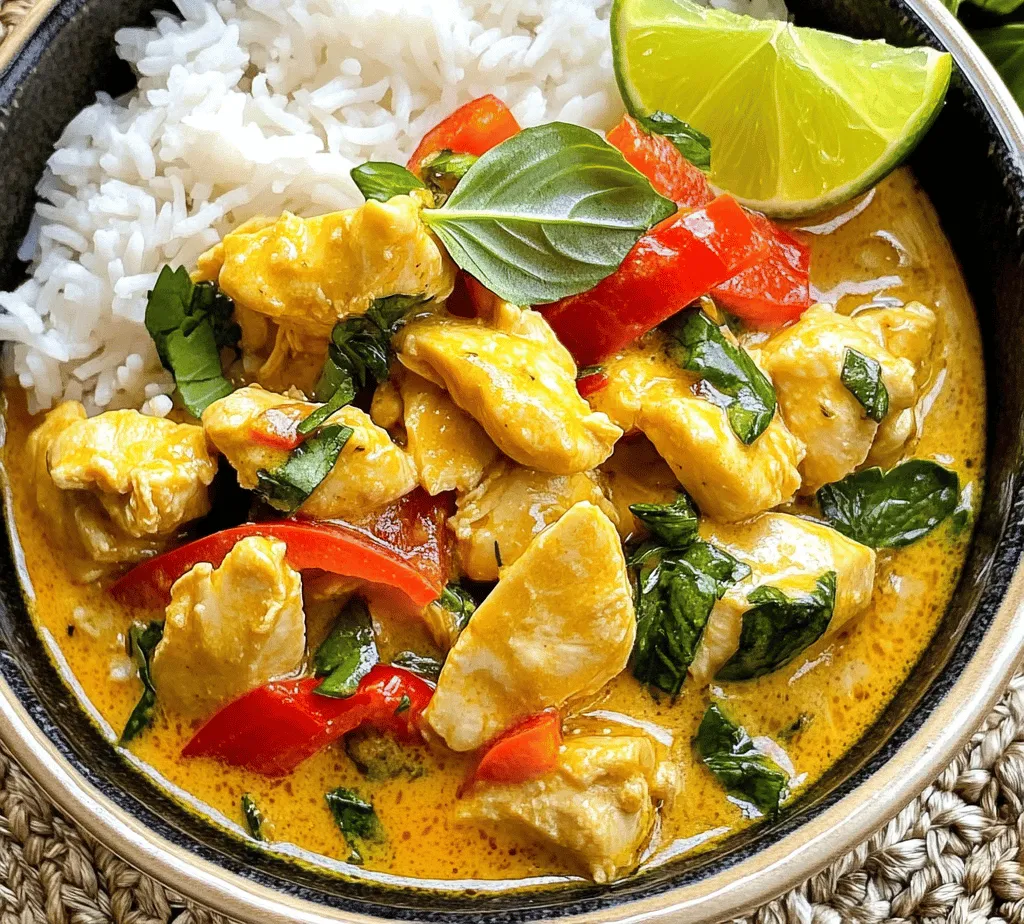
Detailed Walkthrough of the Cooking Process
Creating a Rich & Creamy Chicken Panang Curry is an immersive experience that involves carefully orchestrating flavors and textures to achieve a dish that is both comforting and aromatic. Below, we will delve into the critical steps of this recipe, ensuring that you can replicate this delightful meal with ease.
Sautéing the Curry Paste: Techniques for Releasing Flavors
Begin by heating a tablespoon of vegetable oil in a large pan or wok over medium heat. Once the oil glistens, add your prepared Panang curry paste. Sauté the paste for about 2-3 minutes, stirring constantly. This step is crucial as it allows the natural oils in the paste to release, intensifying the flavors. As you cook, you should notice the fragrance of lemongrass, galangal, and kaffir lime leaves becoming more pronounced, hinting at the deliciousness to come.
Incorporating Coconut Milk: Tips for Achieving the Perfect Consistency
Once the curry paste is well sautéed, it’s time to add the coconut milk. Gently pour in one can (around 400 ml) of coconut milk while stirring continuously. This will help to combine the paste and the milk thoroughly. To achieve the perfect consistency, start with half of the coconut milk and reserve the other half for later. This method allows you to control the thickness of your curry. Bring the mixture to a gentle simmer, allowing the flavors to meld for about 5 minutes.
Cooking the Chicken: Ensuring Juiciness and Tenderness
Next, add the bite-sized chicken pieces to the pan. Stir them into the coconut milk and curry mixture, ensuring they are well coated. Cook the chicken for approximately 10-12 minutes or until the pieces are cooked through, stirring occasionally. To maintain juiciness, avoid overcooking; the chicken is done when it turns opaque and reaches an internal temperature of 165°F (75°C). If you’re using chicken thighs, they will be more forgiving and tend to remain tender even if cooked a bit longer.
Achieving the Right Balance of Flavors: Seasoning with Fish Sauce and Sugar
Once the chicken is cooked, it’s time to season your curry. Add 2 tablespoons of fish sauce for umami depth and saltiness. Follow this with 1 tablespoon of sugar, which will balance the flavors and enhance the natural sweetness of the coconut milk. Taste the curry at this stage; if you find it lacking, feel free to adjust the seasoning with additional fish sauce or sugar, ensuring you achieve a harmonious balance.
Adding Vegetables: Maintaining Texture and Color
To add freshness and texture to your dish, incorporate vegetables such as sliced bell peppers, carrots, and green beans. These should be added after seasoning, cooking for about 5-7 minutes until they are tender-crisp. This method will ensure that the vegetables retain their vibrant colors while contributing a slight crunch to the curry. If you prefer softer vegetables, simply allow them to simmer a little longer.
Final Touches with Basil: Enhancing Aroma and Flavor
As a finishing touch, stir in a handful of fresh Thai basil leaves just before serving. The heat from the curry will release their aromatic oils, elevating the overall flavor profile of your dish. Basil not only adds a burst of freshness but also complements the coconut and chicken beautifully.
Visual Aids and Tips to Enhance Cooking Experience
To enhance your cooking experience, consider having a visual guide or video tutorial on hand. Watching someone else prepare the dish can offer invaluable insights into the texture and consistency you should aim for. Additionally, prepping ingredients beforehand, known as mise en place, will streamline your cooking process and make it more enjoyable.
Serving Suggestions
Presentation Ideas for Serving the Curry
When it comes to serving your Rich & Creamy Chicken Panang Curry, presentation can elevate the dining experience. Serve the curry in a deep bowl, allowing the vibrant colors of the chicken and vegetables to shine. Garnish with additional basil leaves and thin slices of red chili for an eye-catching touch.
Recommended Accompaniments: Jasmine Rice and Lime Wedges
Pair your curry with fluffy jasmine rice to soak up the rich sauce. The fragrant rice complements the curry perfectly and adds a delightful texture contrast. Consider offering lime wedges on the side; their acidity will brighten the dish and enhance the flavors even further.
Pairing Suggestions with Beverages
For beverage pairings, Thai iced tea is a classic choice that balances the spiciness of the curry with its creamy sweetness. Alternatively, coconut water provides a refreshing hydration option that echoes the coconut flavors in the dish.
Nutritional Information
Overview of the Nutritional Benefits of the Dish
Rich & Creamy Chicken Panang Curry is not only a delight for the taste buds but also offers several nutritional benefits. The primary ingredients—chicken, coconut milk, and a variety of vegetables—collaborate to create a wholesome meal.
Caloric Breakdown Per Serving
A typical serving of this chicken curry contains approximately 400-500 calories, depending on the portion size and the amount of coconut milk used. This includes proteins from the chicken, healthy fats from the coconut milk, and fiber from the vegetables.
Health Benefits of Key Ingredients
- Chicken: A great source of lean protein, essential for muscle repair and overall body health.
- Coconut Milk: High in healthy fats, particularly medium-chain triglycerides (MCTs), which can provide a quick source of energy.
- Vegetables: Packed with vitamins, minerals, and antioxidants, they contribute to overall health and well-being.
Cultural Significance of Chicken Panang Curry
The Role of Panang Curry in Thai Festivals and Celebrations
Panang curry holds a special place in Thai culture, often served during festivals and celebrations. Its complex flavors reflect the rich culinary heritage of Thailand and symbolize the warmth of Thai hospitality. Families often gather to share this dish, making it a staple for communal dining.
How This Dish Represents Thai Hospitality and Flavor
In Thai cuisine, food is not just sustenance; it embodies love, care, and community. Chicken Panang curry represents a blend of flavors that reflects the country’s geography and culture. The use of fresh herbs, spices, and coconut milk showcases the abundance of natural resources in Thailand, making it a dish that is both representative and celebratory.
Conclusion
Making and enjoying Rich & Creamy Chicken Panang Curry is a rewarding culinary adventure that brings the vibrant flavors of Thai cuisine into your home. The process of cooking this dish allows you to explore a world of aromatic spices and ingredients, resulting in a meal that is both satisfying and comforting.
As you savor each bite, you’ll appreciate not only the flavor but also the cultural significance of Panang curry in Thai home cooking. We encourage you to embrace the deliciousness of this dish, explore its variations, and share it with family and friends. Discover the joy of cooking Thai cuisine and let the rich flavors of Chicken Panang Curry transport you to a world of culinary delight.
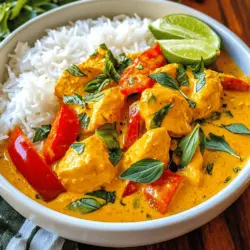

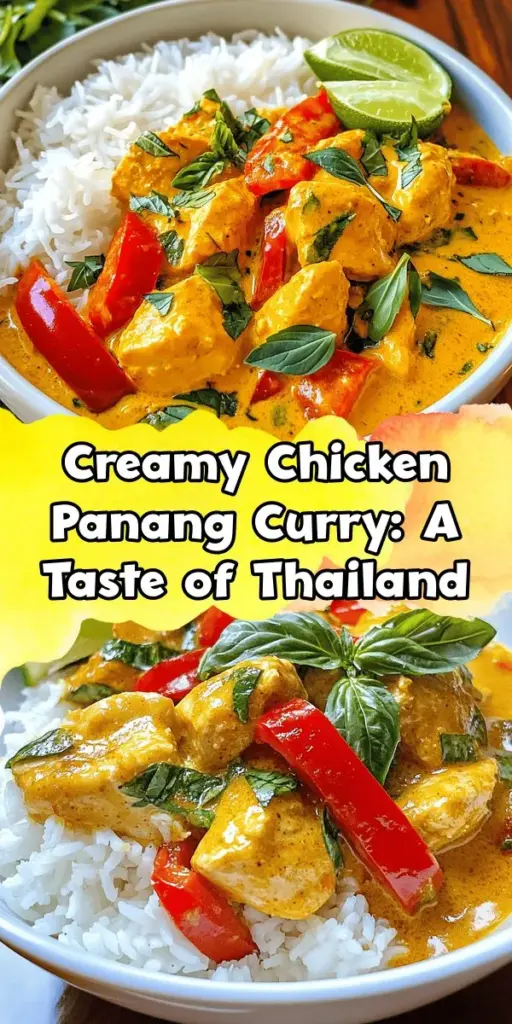

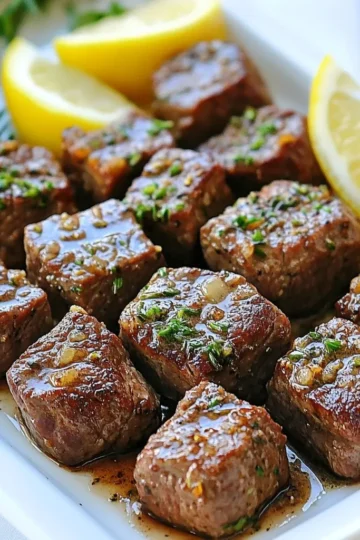
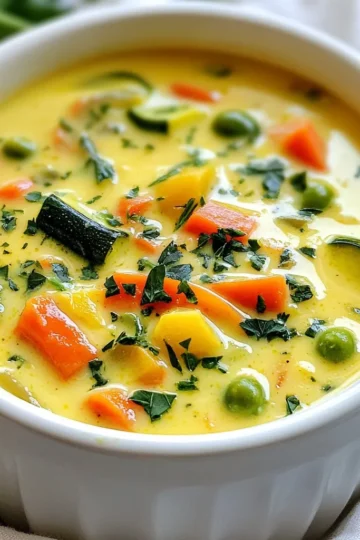
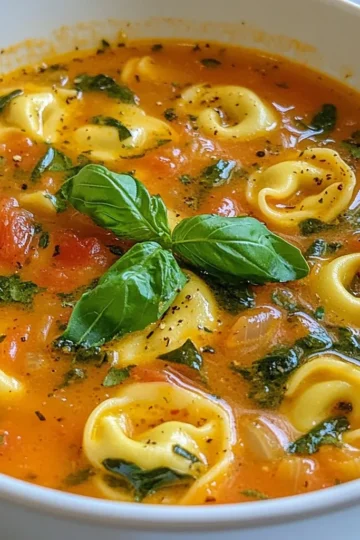
Leave a Reply